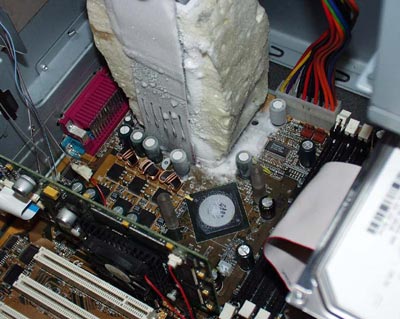Bij overclockers.com is een verhaal verschenen over een gekke Fin (ja, dat lees je goed: geen Jappaner ![]() ) die zijn Thunderbird heeft gekoeld met vloeibare stikstof. De gebruikte hardware was een 1GHz AXIA Thunderbird, een Abit KT7A met voltage mod en Apacer PC133 RAM. Met behulp van de vloeibare stikstof in een zelfgemaakt aluminium bak kon de processor naar -37 C gekoeld waarna hij stabiel op meer dan 2GHz kon lopen. Een indrukwekkend resultaat:
) die zijn Thunderbird heeft gekoeld met vloeibare stikstof. De gebruikte hardware was een 1GHz AXIA Thunderbird, een Abit KT7A met voltage mod en Apacer PC133 RAM. Met behulp van de vloeibare stikstof in een zelfgemaakt aluminium bak kon de processor naar -37 C gekoeld waarna hij stabiel op meer dan 2GHz kon lopen. Een indrukwekkend resultaat:
I filled the box and went back to BIOS to check temps: +4°C and dropping. In a few seconds, it was -37°C and I decided to boot into W2K. When I got to W2K and started, the MBM temp sensor displayed 0°C and the reading didn't change at all. The Temp monitoring chip was probably a bit confused because of the LN2 temp[ED: MBM has to be enabled for below zero readings.]
Then I ran some tests and increased the FSB from 133 MHz (1.6 GHz) all the way up to 168 MHz (2016 MHz), the max of my Apacer RAM. The multiplier was set to 12.
At 2016 MHz, I could run tests like pifast or pipih3 without errors (these tests are more "error sensitive" than, eg., 3DMark2000/1, so the CPU was pretty stable). I could run these tests without errors also at 2030 MHz, but the system jammed there; probably my Fortron 350W power supply just couldn't handle the CPU.
 |
